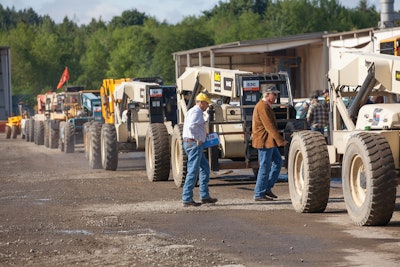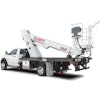
A telescopic handler is an important piece of equipment on any jobsite. But if you’re considering purchasing a used machine for your fleet, there are several areas you should inspect carefully to ensure safe, effective operation.
“When it comes to evaluating used equipment, it’s best to break your evaluation process down based on the individual systems of that machine,” says Paul Hendrix, equipment pricing analyst, IronPlanet.
Following are four key systems to consider, along with other tips to ensure a successful purchase.
Mechanical Systems
Mechanical systems include the engine, drivetrain and hydraulics. Hendrix suggests cranking the engine cold. “Telehandlers are powered by diesel engines and you can learn a lot about the engine by how it cranks,” he says. “If you touch the starter and it cranks, that’s a good sign on a cold start from a diesel engine. If you have to grind on it before it cranks over, that’s an indication that the engine has serious internal wear.”
In addition, look for major leaks and check the condition of all fluids. “It’s also important to run the machine in all gears,” says Chad Weidemann, vice president of sales, Cat Auction Services. “Run the machine through its paces and test each function of the machine. Use all of your senses when testing the unit and pay particular attention to the engine for overall performance, noise and smoke issues.”
If you are in a crowded area that doesn’t allow you to operate the machine to its full potential, Hendrix suggests you can still hold down the brake and shift the machine through its gears. Verify there is power in all gears, forward and reverse.
Check the steering and brakes, including the service and parking brakes. The brakes should stop and hold the machine. Make sure all safety lock-out devices are operating as intended, emphasizes Weidemann. The ROPS/FOPS should not be damaged or modified.
Raise and lower work equipment, listening for unusual sounds and looking for leaks in the hydraulic system. “Telehandlers have a fairly robust hydraulic system,” notes Hendrix. “One group of cylinders telescopes the boom, while load leveling cylinders change the angle of the machine. You need to visually inspect all areas for damage, wear and leaks.”
Structural Systems
Inspect the boom carefully, starting at the hinge point from where the boom is anchored to the frame of the machine. Extend the boom out and inspect each section for signs of cracks, welds or repairs. Ensure the boom angle and frame level gauges are working freely.
Be cautious when it comes to repairs to the boom structure. “Boom repairs do exist, and more times than not the repairs are obvious,” says Weidemann. “The use of a straight edge across the bottom of the boom and up the sides between the flanges is a good way to check for boom box deflection.”
“The structural integrity of any kind of lift equipment is very important because every part of that machine is designed to carry the load,” adds Hendrix. “If any part has failed in the past or been repaired, it might compromise the overall integrity of the machine and its ability to lift the load.”
Weidemann suggests raising the telescopic boom to maximum height, extending the boom all the way out and then retracting it to make sure it is not binding and shuttering during retraction. Repeat the same procedure in a horizontal plane, this time looking at the boom deflection at maximum horizontal reach, again making note of any binding or shuttering during retraction.
On the end of the boom, make sure the attachment is properly matched to the size and load capacity of the telehandler. “Before purchasing a used telehandler, it is important to make sure the attachment matches the machine, and never use an attachment on an undersized machine,” says Weidemann. “Keep in mind that some attachments will accelerate machine wear, which may require more frequent servicing. The incorrect attachment on a machine could become a serious safety factor.”
Last but not least, look over the main frame of the machine for evidence of welds, plates, damaged or cracked areas. Look for places where cylinders and axles attach. Verify that the axles oscillate. Identify the steering capabilities (two wheel, four wheel and/or crab) and inspect the hinge points and places where parts attach to the frame.
Appearance
“The overall appearance of a machine is a telltale sign of the way it has been maintained,” says Doug Olive, vice president, pricing and valuation, Ritchie Bros. Auctioneers. “Generally, you can get a good feeling of what the maintenance was like on the machine during a walk-around inspection.”
Hendrix advises inspecting the cab to get an indication of how the machine was cared for. Positive signs are a clean interior, unbroken glass and a seat that is in good condition. Check that the controls aren’t taped with duct tape and there are no wires hanging under the dash. “Take the time to notice these little things, as there are many small signs inside the cab that tell how a machine has been maintained,” he comments.
Check for damage to sheet metal or fiberglass, fenders and paint. Are all the panels (e.g., engine panels) and glass intact? Is there tread left on the tires?
Tires are one of the fastest wearing components on a telehandler and account for a significant amount of downtime. They can be filled with air or foam, so know which tires are on the machine you are considering purchasing.
“Foam is more expensive to replace as the tire must be cut from the rim,” explains Hendrix. “Pneumatic tires are easier to replace, but can be punctured and go flat.”
Hendrix suggests inspecting for sidewall damage, inside and out. Check the tread wear, as well, to determine how soon the tires will need to be replaced.
Maintenance Matters
“A work order and proper maintenance are important pieces of information that should be evaluated prior to purchasing a used telehandler,” says Olive. Beware of any machine that doesn’t come with a maintenance history.
“Documentation is very important and, when it’s available, it will give you the best history of how a machine has been treated and maintained,” says Weidemann. “Anytime there is documented maintenance, it’s a plus for the buyer.”
Confirm the time between servicing, as well as the types of repairs performed. If a boom structural repair is found on a machine, ask for documentation of the repair. Since a telehandler has the capability to lift personnel, you want to make sure it has been repaired to manufacturer specifications.
While documentation is beneficial, there are some telltale signs that a machine has not been properly maintained. “The easiest sign of lack of maintenance on a telehandler is oil leaks,” says Weidemann. “If the machine looks abused, chances are it has been.”
Another sign of neglect or abuse is the tires. Worn tires are fine, but severely damaged tires are not. Also, normal wear will not bend forks or carriages.
If a telehandler has been improperly used to dig or pull something, it will often damage the internal chains and hoses, Weidemann points out. This damage ranges from the chains being very loose or the boom section falling back into the section when the boom is raised. Verify that the boom sections are not bent if you suspect improper use of the machine.
A used telehandler can be a valuable addition to your fleet. However, do your homework before you purchase. Research manufacturer websites and inspect equipment carefully before making a decision.
Of course, there are circumstances where it makes more sense to buy a new telehandler. Weidemann suggests taking the following into consideration before purchasing any machine: warranty, replacement cost, reliability, the role of the machine (how critical it is to production) and the rebuild costs.




















